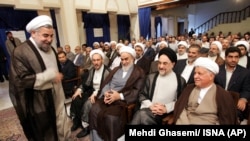Two comparative studies conducted in 2017 and 2020 about the situation of Iran's economy under its latest four presidents reveal that President Hassan Rouhani's economic performance has likely been the worst of the bunch, particularly during his second term in office.
Ironically enough, neither of these reviews -- the first published on pro-reform news website Fararu on August 17, 2020 under the headline "Is Hassan Rouhani the worst Iranian President after the 1979 revolution?", and "The statistical track record of four administrations," published by Iran's leading economic daily Donya-ye Eqtesad on May 31, 2017 citing the Majles Research Center -- cover former President Ali Khamenei's economic performance between 1981 and 1989.
The two presidents before Khamenei did not serve long enough to have a track record, but the two studies’ reasons for not taking into account Khamenei's presidency likely stem from Khamenei's status as the current Supreme Leader, since reviewing his performance is a frowned-upon practice for Iranian media.
Under Khamenei's presidency, Iran’s prime minister at the time, Mir Hossein Mousavi, was in charge of the administration's executive affairs including economic matters. Discussing Mousavi's economic performance is also seen as taboo for different reasons, as he remains under house arrest for refusing to accept the results of the 2009 Presidential election that led to the presidency of Khamenei-backed Mahmoud Ahmadinejad.
The 2020 review by Fararu maintained that the presidency of reformist President Mohammad Khatami, between 1997-2005, saw the smallest inflation rate and the least amount of increase in the rate of exchange for the U.S. dollar, as well as the prices of gold, housing and fuel.
The review also claimed that Iran experienced its highest inflation rate, at 49 percent, under President Akbar Hashemi-Rafsanjani from 1989 to 1997. While the official inflation rate under Rouhani has been announced to be around 42 percent, market activists believe the actual figure is far higher than that, probably even higher than the rate during Rafsanjani's presidency.
The biggest increase in the price of gold, housing and fuel in Iran, took place under ultraconservative President Mahmoud Ahmadinejad (2005-2013).
Fararu's yardsticks for judging the presidents' performance include the difference between the exchange rates for U.S. dollar, and the price of standard gold coin, the cost of housing and the price of gasoline at the beginning and the end of individual presidencies.
To compare the change in exchange rates for U.S. dollar under individual presidents under the Rafsanjani administration, the dollar exchange rate rose 3.9 times higher between President Rafsanjani's first and last day in office.
The figure was 1.9 times higher under President Khatami, 3.5 times higher under President Ahmadinejad, and 5.6 times higher under President Rouhani who still has one more year to serve.
According to Fararu, the current 250,000 rial rate of exchange for the dollar, as well as the 110 million rial price of a standard gold coin, the 200 million rial per square meter of average housing and the 30,000 rial per litre price of gasoline, all make President Rouhani Iran's least successful president in the economic realm. The fact that he has less than a year to improve the situation makes his prospective legacy even worse.
Nevertheless, President Rouhani's situation looks better in the Majles Research Center and Donya-ye Eqtesad's review from 2017, which only covers his administration up to the end of Rouhani's first term of office, when he was more-or-less successful thanks to the nuclear deal he made with big powers in 2015.
Iran's economy had a bleaker showing in Rouhani's second term, particularly after 2018, when the United States pulled out of the nuclear deal and imposed heavy sanctions on Iran, including its oil sale as well as its international trade and banking.
The 2017 review, which has a more academic nature, is based on a set of criteria including the inflation rate, oil and natural gas revenues, economic growth rate, the number of jobs created, the share of oil and gas export in the economic growth, the ratio of the cost of food stuff to the total cost of families, and the real increase in wages.
This review states that during the decade ending in 2017, the economic growth in Iran was of a kind that did not produce jobs. In fact, the least number of jobs created in Iran under the four presidents occurred in the years between 2008 and 2014.
The 2017 review observed that the rate of economic growth depended mainly on oil revenues, which explains why the growth rate has been negative in recent years.
In terms of the rate of inflation between 1989 and 2017, the smallest inflation rate (14.5 percent) was observed during the second term of office of President Khatami (2001-2005) while the highest inflation rate was experienced during the second term of office of President Rafsanjani (1993-1997). This, to some extent, explains how citizens’ frustration led to major changes and brought a reformist administration to power.
Considering Iran’s history, if present-day conditions in the country remain the same, the economic frustration under the Rouhani administration could potentially lead to an even more drastic change.







